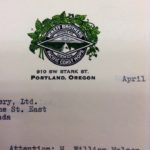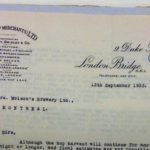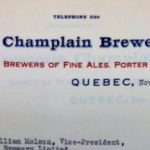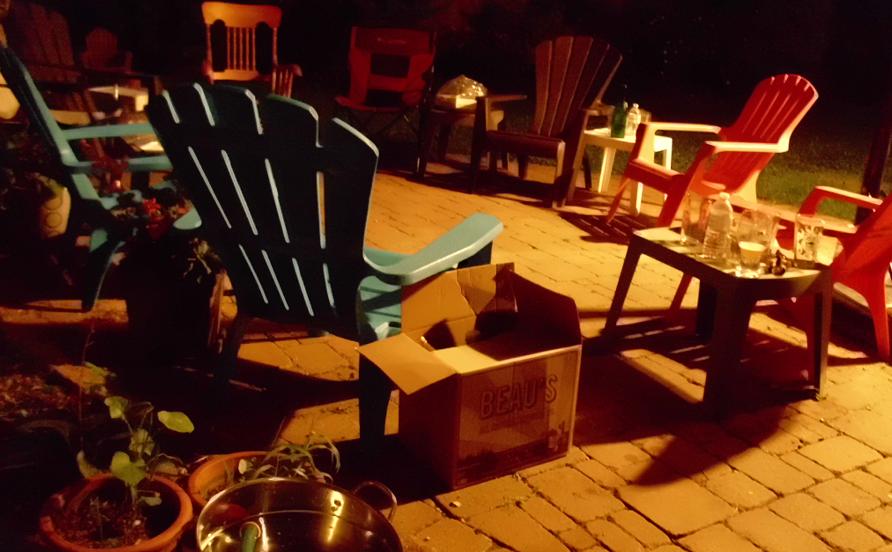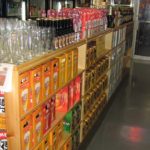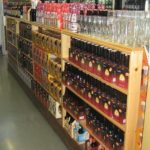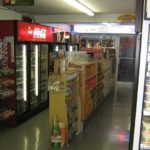Now there’s a sexy title for a blog post. A real whooah-ish search engine optimization blog post title. Letterhead Pr0n. I should have paid more attention to the lighting when I was at the archives last week with Jordan in Ottawa. But, still, these are pretty sweet. It is amazing how elaborate the Taylor and Bates letterhead is. Rich old guys in suits drinking beer and having the time of their lives because they own a brewery and a radio station.
Category: Quebec
When Did I Last Shop At The Beer Store?
I won’t have to worry about this for a while:
To get a sense of how much the lack of competition affects beer prices, Sen compared pre-tax beer prices in Ontario and Quebec. The price of a 24-pack (the average of several brands such as Molson Canadian or Bud Light) came to about $26 in Quebec grocery stores, and about $36 at the Ontario Beer Store. Sen estimated that the extra money, about $700 million, “is going directly from consumer pockets to a consortium with majority ownership by foreign-based firms.” (The Beer Store disputes those numbers, saying Sen compared pre-tax to post-tax prices, ignored commodity tax differences and used a small sample.)
What can you say when your face numbers like that. Anything I have to say is framed by the fact that it really doesn’t affect me. I buy good beer at the LCBO, in a pub, from the brewery or on jaunts into nearby northern NY or Quebec. The Beer Store, even with its generalist’s name, has found itself in the position where its stock is specialized, limited to those beers that don’t really qualify as craft or for the most part all that interesting. When you think about it, the good beer buyer in Ontario is really well served by this physical retail reality, the separation of macro beer from the better stuff.
And I will really not be able to concern myself as it’s time to drive the family from brewpub to micro brewery to good beer store in a random selection of US states for a while. What should I get that’s new in Maine? What’s the best place to eat with the family near Fenway? Do any brewpubs offer mini putt? These are the questions for the next wee while. Ontario’s macro retail off shore monopolists? What are they to me?
Ontario: When Was The First Beer Downed Here?
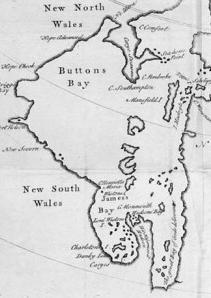 A puzzle. As has been noted, Jordan and I have accepted the offer to co-write a book on beer and brewing through Ontario history. It is part of the series put out by The History Press series on regional brewing histories. Which leads to lots of questions. Like… how does one write a history? But that is a big question. A more specific question is what was the first beer consumed in what is now Ontario. One candidate is the beer found in the hold by the mutineers of Henry Hudson’s ship in 1610 who set poor Captain Hank and a few others adrift in James Bay and then set to ripping the Discovery apart as recounted in 1625 by one sailor who was present:
A puzzle. As has been noted, Jordan and I have accepted the offer to co-write a book on beer and brewing through Ontario history. It is part of the series put out by The History Press series on regional brewing histories. Which leads to lots of questions. Like… how does one write a history? But that is a big question. A more specific question is what was the first beer consumed in what is now Ontario. One candidate is the beer found in the hold by the mutineers of Henry Hudson’s ship in 1610 who set poor Captain Hank and a few others adrift in James Bay and then set to ripping the Discovery apart as recounted in 1625 by one sailor who was present:
…there were some of them that plyed their worke, as if the Ship had beene entred by force, and they had free leaue to pillage, breaking vp Chests, and rifling all places… In the Hold they found one of the vessels of meale whole, and the other halfe spent, for wee had but two; wee found alſo two firkins of Butter, some twentie seuen piece of Porke, halfe a bushell of Pease, but in the Masters Cabbin we found two hundred of bisket Cakes, a pecke of Meale,of Beere to the quantitie of a Butt, one with another.
The trouble is that while it is clear that the mutiny was in James Bay but not clear that the mutineers drained the beer at or near the western half of the bay’s shore line that later becomes Ontario as opposed to Quebec. They do keep the eastern shore in sight on the way home after they abandon Hudson and the others left to their own devices. But that was after they gunned the beer. Where did they do that? Such problems I have. Well, not the sorts of problems these lads me but, you know, modern problems.
Quebec: Retirements And Consolidation At McAuslan
If I have a favorite beer at a favorite pub, it’s a pint of McAuslan Oatmeal Stout at the Kingston Brewing Company. It does not hurt that the place is a block from my work. But news has thrown a pebble at my world just now, placing that pleasure at perhaps some risk:
After a quarter century in the business, the husband-and-wife team behind the McAuslan Brewing company has sold their company to another Montreal-based microbrewer, RJ Brewers. Peter McAuslan, who founded the company with his wife Ellen Bounsall in 1988, told CJAD News it was just the right time for the two of them to get out. “When one starts a business, you always have a sort of an end point in mind,” McAuslan said. “Both of us over the last ten years said, ‘well, there’s going to come a point where we’re going to want to sell out and take advantage of the work that we’ve done.”
Risk you say? Don’t get me wrong. I have had RJ’s Belle Gueule and it has its worthy place. But successors rarely maintain the particularity of a beer even if quality generally is maintained. Different equipment, hands on the knobs, water tables or yeast strain races? You’re never sure about these things. With luck, I’ll stand corrected this time and that wee note of licorice will be there along the twiggy hops for years to come. Good news for the team of McAuslen and Bounsall certainly and perhaps part of an era we’ll be entering where many such just rewards are gotten by many more retiring first wave microbrewers.
But, really, it’s not like I drank the beer because of them. I drink it because of it. And I hope it has many more years ahead of it.
Beau’s Thursday Night Tasting In the Backyard
A fun way to spend the evening. Beau’s had their quarterly business meetings in town and they all came over for a few hours of opening bottles – including the father, son and a sizable host. We nine started well with two saisons and biere de garde: Hennepin, Jack D’or and 3 Monts. Batch 10 from Pretty Things was much better than the more recent bacth 13. Lesson: let it sit.
Things got a little wobbly with three Quebec takes on Belgian white beer. We thought RJ’s Coup de Grisou was fine and a good value beer. And Barbier from L’Ilse D’Orleans was not well understood given its level of rich maltiness. But Blanche from Charlevoix was a revelation in nasal interaction with beer. Freesia. Fabulous.
Three more bottles were opened. Trade Winds Tripel from the Bruery was a bit muddled with a nice aroma. Too much of the malt ball for the style or maybe just our level of interest given the other choices. Next, the Poperings Hommel Ale, as always, was amazing. The greatest pale ale in the history of the planet? Could be.
Then the taxi was called for the eight to be off. It was time. The mosquitoes had begun to bite. Just time to open a quart of Drie Fontienen’s Oude Gueze, one of the few beer that could follow a Poperings. Like any divider of people, some were not with it. They got the first taxi. The rest of use stood on the driveway, waiting on the warm quiet summer night sipping. Then the taxi and then they were off and away.
Grill, Shed, Steak, Rain, Bieres de Garde And Saisons
 The trouble with charcoal grilling is that when the rain comes you can’t turn it off. Propane, on the other hand, has a nice dial that has a “0” setting. But there is the garden shed and, when it rains and you have visitors, it can turn out to be a delightful place to while away a late afternoon hour reading last week’s newspapers in the recycling bin, listening to AM radio and comparing a few examples of bieres de garde and saisons.
The trouble with charcoal grilling is that when the rain comes you can’t turn it off. Propane, on the other hand, has a nice dial that has a “0” setting. But there is the garden shed and, when it rains and you have visitors, it can turn out to be a delightful place to while away a late afternoon hour reading last week’s newspapers in the recycling bin, listening to AM radio and comparing a few examples of bieres de garde and saisons.
We opened the Ch’ti Blonde from Brasserie Castelain à Bénifontaine first, a gold ale called a saison (though French not Belgian) by the BAers but a biere de garde by Phil Markowski in his book Farmhouse Ales under a white mouse head that resolved to a froth and rim. It was the favorite of the set with cream malted milk, pear juice and nutty grain. Very soft water. I actually wrote “limpid cream of what graininess” but I am a little embarrassed by that pencil scribble. It gets a fairly poor rating from the BAers but maybe that is because they were not in a shed when they tried it. Castelain’s Blond (no “e”) Biere de Garde was drier but still creamy fruity, not far off the greatest example of a Canadian export ale. Light sultana rather than pear. Also dry in the sense of bread crusty rather than astringency. Lighter gold than the Ch’ti but, again, the rich firm egg white mousse head and far more BAers approve. By this time the shed dwellers had decided that steak could in fact be finger food and also that these ales were an excellent pairing with chunks of rib and New York strip. The Jenlain Ambree by Brasserie Duyck was another level of richness altogether, the colour of a chunk of deep smoked Baltic amber, the richest lacing I have ever seen left on a glass. Hazelnut and raisin, brown sugar and black current with a hint of tobacco. Lately I have been thinking that amber ales are the one style that could quietly slip away and never be missed. Placing this in the glass in the hand in the shed as the rain thumped on the roof and steak was eaten was an instructive treat as to what ambers can be, though 6% of BAers hesitate to be so enthusiastic.
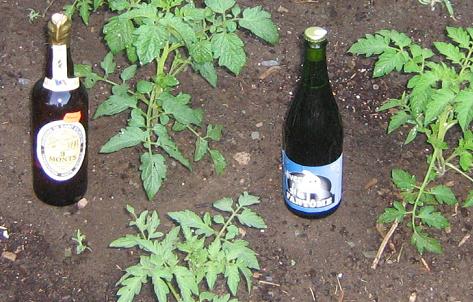
I think this is the worst photo I have ever posted so I will keep it tiny unless you choose to click on it for the full effect. Apparently there is a limit to the beery photographic arts and I have made it my own. The 3 Monts to the left was picked up at Marche Jovi in nearby Quebec for a stunningly low price of under six bucks. Plenty of malteser and pale malt graininess with yellow plum and apple fruitiness, straw gold with more of the thick rich head, cream in the yeast. The water was not as soft was either beer from Castelain but all BAers love it. By Brasserie De Saint-Sylvestre who also made this biere nouvelle. To the right, the Fantome Winter was one of the stranger beers I have ever had and, frankly, a disappointment. All I could taste was radish, sharp and vegetative, over and all around the insufficient malt. In my ignorance, I didn’t realize that was likely quite an aged beer as the happy BAers explain. Neither the cork or even label, with its unmarked best before portion, give a hint as to the year but that is all right as I suspect I will consider this just a lesson learned even though I generally love Fantome.
By this time there were stars and a breeze as the cold front finished moving through.
Beer Hunting in Michigan and Quebec
I have a couple of big trips coming up in October. Circumstances place me to the west in London, Ontario relieved of duties before noon on a Friday which means I have an hour to head further west still to the border at Sarnia and the afternoon to shop in Michigan. Having been there before, I have a sense of what I am looking for: something wet hopped, a case of Two Hearted Ale…as well as a little Bud American Ale…just to see. I don’t think I’ll make it as far as Jolly Pumpkin but Ron has given me the name of some of his most north-easterly clients so with any luck I will land some anyway.
The next weekend, however, sends me far east through largely uncharted territory as I head to a small IT/brainiac conference called Zap Your Pram in PEI. I will try to stop in a few government stores out east but on the way back on Sunday, I hope to hit a beer store or two in Quebec City like Le Monde des Bieres or Dépanneur de la Rive. I want to get my hands on some Dieu du Ciel for sure but, as John Rubin mentions in today’s Toronto Star, there are plenty of Quebec-made brews we never hear about in English-speaking Canada. The same is true of any regional brews due to our wacko inter-provincial trade restrictions but Quebecers, arguably, have a taste for a broader range of flavours than the rest of we Canucks and it shows in their brews. So maybe I’ll grab something from Microbrasserie Charlevoix or Hopfenstark, both unknowns to me but well regarded by the BAers.
Any hints before I undertake the 4,000 km two-part tour?
Beer Shop: Marché Jovi, Gatineau, Quebec
 A run to Ottawa to see the Billy Bragg show on Saturday meant the opportunity to do a Sunday morning run to one of the better shops in Western Quebec for craft beer, Marché Jovi in Gatineau, Quebec. The shop is handy for anyone near Ottawa’s Island Park Drive and the bridge to the other side and sits near the gate of Gatineau Park.
A run to Ottawa to see the Billy Bragg show on Saturday meant the opportunity to do a Sunday morning run to one of the better shops in Western Quebec for craft beer, Marché Jovi in Gatineau, Quebec. The shop is handy for anyone near Ottawa’s Island Park Drive and the bridge to the other side and sits near the gate of Gatineau Park.
 Inside you are met with one of the tidiest depanneurs I have ever come across. I asked if I was able to take some pictures and, one bien sur later, was being escorted around the place by a very friendly guy in a dapper white grocer’s jacket. He was proud to show of the selection, let me know that there was new stock coming in and took particular pride in noting the selection of glassware – quite the thing for what you would think was a corner store – and the fact that the regular customers were quite knowledgable in their correct use. I also picked up a copy of the autumn issue of Le Sous-Verre: L’actuality de la biere!, a free craft beer newspaper out of Montreal…a review of which Google has butchered in translation here.
Inside you are met with one of the tidiest depanneurs I have ever come across. I asked if I was able to take some pictures and, one bien sur later, was being escorted around the place by a very friendly guy in a dapper white grocer’s jacket. He was proud to show of the selection, let me know that there was new stock coming in and took particular pride in noting the selection of glassware – quite the thing for what you would think was a corner store – and the fact that the regular customers were quite knowledgable in their correct use. I also picked up a copy of the autumn issue of Le Sous-Verre: L’actuality de la biere!, a free craft beer newspaper out of Montreal…a review of which Google has butchered in translation here.
As Blork noted almost two years ago now, buying beer in Quebec is similar to much of the States. You can get your beer and your corn flakes and your milk all in one stop. Usually this means one large stack of macro brew – as it does most place in the states – but where the owners have imagination and the knowledge, you can create a small oasis like you find at the Galeville Grocery near Syracuse or in pretty much any place in Portland Maine. Usually it also means a walk in cooler.
Most of the stock was Quebec products including macrobrews (inlcuding Labatt Porter) but also many craft beer from breweries like Unibroue, Saint-Arnould, Les Brasseurs RJ, Ferme-Brasserie Schoune. Blork has already reviewed the white beer made by each of the last three. I picked up mixes sixes from Saint-Arnould and Schoune for ten bucks each as well as a couple of large format imports from Saint Sylvestre of France (on special for $5.79) as well as a 330 ml Floreffe dubble from Belgium. Interesting to note that Blonde d’Achouffe is being brewed by license by Les Brasseurs RJ and was included in their six pack.
I would definitely go again, especially with the indication that there were going to be additions to the stock on a regular basis. Clean and helpful with a good selection and good price. What ele could you want from a corner store?
National Six-Pack VIII: Raftman, Unibroue, Quebec
 You think it is February. Nothing will surprise you in February when you are as many weeks from Yule as you are to spring. Month o’ the rut. Then, you try a brew that you have never gotten around to trying and the world is all sunshine and love…or at least has one more good brew to tell folks about.
You think it is February. Nothing will surprise you in February when you are as many weeks from Yule as you are to spring. Month o’ the rut. Then, you try a brew that you have never gotten around to trying and the world is all sunshine and love…or at least has one more good brew to tell folks about.
I really like this ale. Likes it, I do. 5.5% at a pretty basic price at the Beer Store. It is like a cross between a great Belgian witte and a great Canadian pale ale. A bit spicy, gingery orangey/lemony but also a big husky grainy profile as well. There is a yeast deposit that tastes decidedly spice-a-lee Belgian but a careful pour leaves the ale bright in the glass. The colour is more deep dark straw than amber – no red to my eye. The head stays around in a nice lively fine foam. It is the kind of beer you could smell for an hour, sticking half your face in the glass – you could if your wife or pals or children would not laugh at you for being a dork.
The brewery, Unibroue says of one of its lighter offering Raftman:
Launched in March 1995, Raftman is a beer with a coral sheen that is slightly robust. It contains 5.5 percent alcohol and combines the character of whisky malt with the smooth flavours of choice yeast. It has a subtle and exceptional bouquet that creates a persistent smooth feel. Raftman complements fish, smoked meat and spicy dishes. It is brewed to commemorate the legendary courage of the forest workers. These hard working men knew when to settle their differences and share their joie de vivre with a beer and a whisky.
The brewer twice notes “smoked whisky malt” as a part of the mash but it is a pretty subtle smoke if it is there at all. Still, it is Big Joe Mufferaw ale. Ale for men in plaid. Beer for lumber bars like Fred’s in Chapeau or the Silver Maple back of Shawville. Click on the photo for a plaidly scale version. The beer advocates do not go all rang-dang-do ever it but lots like it.So far, tied best of the National Six-Packs along with St-Ambrose Pale. Two Quebecers leading the pack. Who knew?
Quick Note: Labatt Porter
 While on the road, I chanced by a depanneur near the pulp mills in downtown Hull and found an artifact, Labatt Porter. This beer is a vestige of an earlier style of Canadian beer which died away as lagers came on to the scene. Old lumberjack taverns up the Outaouais may still have old sign for porter painted on their outside brick walls. Ten years ago Molsons still produced a competing beer under the brand Champlain Porter. Now only this one is left and likely has one of its few remaining bases of popularity, such as it is, on the Quebec side of the Ottawa River. It is really a sweet milk stout. It is chocolatey, lactose sweet, a bit like a richer cola with low carbination and the aroma of new baked bread and caramel. It is not hoppy like the Sleeman Fine Porter or roasty like Cooperstown Benchwarmer. Not profound but comforting. Probably the best tasting beer for style Labatt still brews – which is not a great compliment. It may be gone itself in another decade. Click on the photo for a better view.
While on the road, I chanced by a depanneur near the pulp mills in downtown Hull and found an artifact, Labatt Porter. This beer is a vestige of an earlier style of Canadian beer which died away as lagers came on to the scene. Old lumberjack taverns up the Outaouais may still have old sign for porter painted on their outside brick walls. Ten years ago Molsons still produced a competing beer under the brand Champlain Porter. Now only this one is left and likely has one of its few remaining bases of popularity, such as it is, on the Quebec side of the Ottawa River. It is really a sweet milk stout. It is chocolatey, lactose sweet, a bit like a richer cola with low carbination and the aroma of new baked bread and caramel. It is not hoppy like the Sleeman Fine Porter or roasty like Cooperstown Benchwarmer. Not profound but comforting. Probably the best tasting beer for style Labatt still brews – which is not a great compliment. It may be gone itself in another decade. Click on the photo for a better view.





